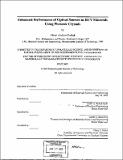| dc.contributor.advisor | Leslie A. Kolodziejski and Lionel C. Kimerling. | en_US |
| dc.contributor.author | Erchak, Alexei A. (Alexei Andrew), 1976- | en_US |
| dc.contributor.other | Massachusetts Institute of Technology. Dept. of Materials Science and Engineering. | en_US |
| dc.date.accessioned | 2005-08-23T20:12:46Z | |
| dc.date.available | 2005-08-23T20:12:46Z | |
| dc.date.copyright | 2002 | en_US |
| dc.date.issued | 2002 | en_US |
| dc.identifier.uri | http://hdl.handle.net/1721.1/8441 | |
| dc.description | Thesis (Ph.D.)--Massachusetts Institute of Technology, Dept. of Materials Science and Engineering, 2002. | en_US |
| dc.description | Includes bibliographical references (p. 205-216). | en_US |
| dc.description.abstract | This thesis applies the unique properties of photonic crystals to enhance the performance of several III-V optical sources. Emphasis is placed on the primary limitation of using photonic crystals for III-V optical sources: nonradiative recombination pathways introduced at the high dielectric contrast interfaces of the photonic crystal. Chapter 1 begins the thesis by providing a theoretical and historical framework for photonic crystals, and lays the foundation for the design of the novel optical sources presented in the later chapters. Chapter 2 develops a framework for improving the external efficiency of a semiconductor LED using photonic crystals. The design, fabrication, and testing of a novel high-efficiency semiconductor LED is described in detail. To improve coupling to radiation modes without introducing nonradiative surface recombination pathways, a triangular lattice photonic crystal in two-dimensions is etched into the top layer of an asymmetric InGaP/InGaAs quantum well structure emitting at 980 nm. Enhanced injection and external efficiency of the LED is demonstrated. Chapter 3 develops methods of laterally steam oxidizing AlAs into A1203 to form large-area wide stop-band one-dimensional Al203/GaAs photonic crystals. The mechanical stability of the high-dielectric contrast interface determines the quality of the photonic crystal and is therefore explored in detail by examining the AlAs steam oxidation process. The A1203/GaAs photonic crystal is integrated with an InP/InGaAs absorber region and used to self-start ultra-short 35 femtosecond pulses in a Cr4+:YAG laser. Chapter 4 develops the design, fabrication, and testing of a novel low-threshold microcavity laser. | en_US |
| dc.description.abstract | (cont.) Feedback in the microlaser is provided by a one-dimensional photonic crystal embedded in a ridge-waveguide containing an InGaP/InGaAs quantum well structure emitting at 980 nm. The rate equations are solved for the microlaser and several models are developed that identify the key role of nonradiative recombination on the threshold properties of the microlaser. Chapter 5 concludes the thesis and presents several potential pathways for future work. | en_US |
| dc.description.statementofresponsibility | by Alexei Andrew Erchak. | en_US |
| dc.format.extent | 216 p. | en_US |
| dc.format.extent | 25911085 bytes | |
| dc.format.extent | 25910844 bytes | |
| dc.format.mimetype | application/pdf | |
| dc.format.mimetype | application/pdf | |
| dc.language.iso | eng | en_US |
| dc.publisher | Massachusetts Institute of Technology | en_US |
| dc.rights | M.I.T. theses are protected by copyright. They may be viewed from this source for any purpose, but reproduction or distribution in any format is prohibited without written permission. See provided URL for inquiries about permission. | en_US |
| dc.rights.uri | http://dspace.mit.edu/handle/1721.1/7582 | |
| dc.subject | Materials Science and Engineering. | en_US |
| dc.title | Enhanced performance of optical sources in III-V materials using photonic crystals | en_US |
| dc.type | Thesis | en_US |
| dc.description.degree | Ph.D. | en_US |
| dc.contributor.department | Massachusetts Institute of Technology. Department of Materials Science and Engineering | |
| dc.identifier.oclc | 50658497 | en_US |
